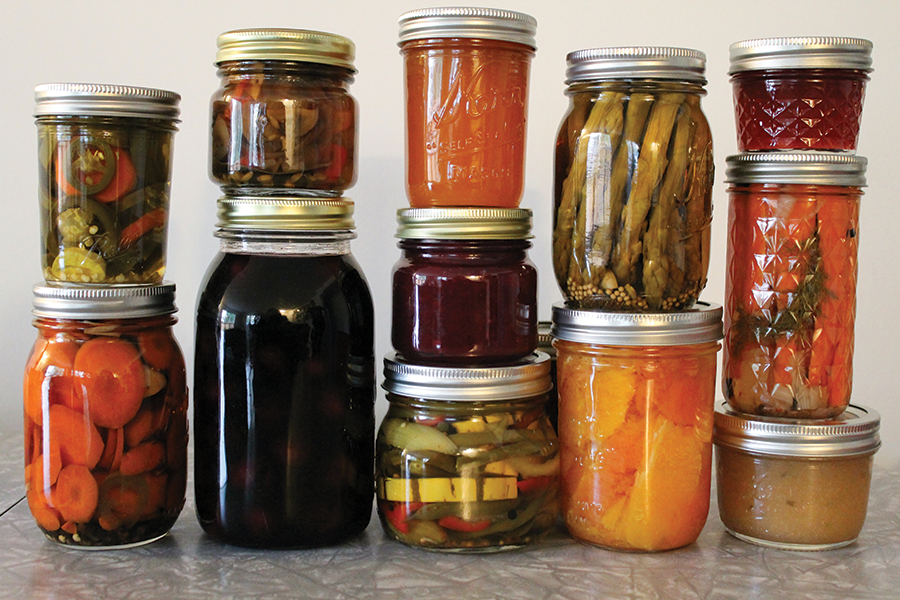Page 4 of 14

- Darby Doyle
Shut Your Lid and Can It
All hail the Mason jar!
By Darby Doyle
There are times in life when even the most adept homemaker must defer to the experts. For instance, I still don't understand how electricity works, so I'm not going to dive in screwdriver-first with the attitude, "Welp, I'll just mess around with these here wires and hope for the best."
Canning, my friends, is in the same category for food science. You just don't fuck around with botulism.
Unlike a lot of my friends who are brand new to canning, I grew up in kitchens where "putting up" our household bounty was a year-round endeavor. I took jars of my mom's homemade plum jam to college to slather on biscuits when I was feeling homesick (Hello, freshman 15). At my Grandma Audra Belle's farmhouse kitchen, we regularly dragged out her heavy pressure canner to preserve their steelhead haul, venison stew, chicken stock or garden tomatoes.
Years later, I started out my first solo canning season with a mish-mash of inherited canning equipment, jars I picked up at Deseret Industries and a stack of earmarked cookbooks. The super-cautious side of me thought it might be a good idea to check in with the most up-to-date info on the food science side of things. Again, botulism. No bueno.
Also, I was seriously shook from hearing horror stories of exploding pressure cookers and suspect jar seals. In retrospect, I realized my grandma had probably played a little fast and loose with the chemistry side of things and relied on memory for most of her recipes. My husband was convinced that I was going to kill us all if I didn't do a little modern recon.
It was time for a reboot.
Fortunately for we denizens of Deseret, there are plenty of free or very affordable professional mentoring programs out there to make sure people are approaching canning with safety and confidence. Several years ago, I took a few community outreach classes led by the Canning Queen of SLC, Alison Einerson, and other local experts. There, they covered the fundamental science and protocols for safely preserving the basics: pickles, salsa and jam. These "Summer in a Jar" workshops are now run by Urban Food Connections of Utah in partnership with Slow Food Utah and Harmons Grocery (see more at slcfarmersmarket.org).
Take-aways from those early days of my canning re-education? Trust the science.
Like assembling pesky IKEA furniture and setting the cable remote, following the goddamn directions will save you a lot of time and grief when it comes to canning. It's crucial to have enough acid involved to inhibit dangerous cooties from taking over—in pickles that usually comes from vinegar; in jams and jellies, lemon juice. Einerson was adamant on this point: use recently-published cookbooks and recipes developed under laboratory conditions where they've established reliable pH levels. Meticulously clean your equipment. Also, most recipes are developed at sea level, so canning at higher elevation requires adding more minutes to the total processing time (there are charts; use them). If in doubt, defer to the long-standing Mason jar experts at Ball & Kerr (freshpreserving.com). These folks know their shit.
Next up? Getting over my terror of pressure canning. While water bath (you know, the boiling water method) preservation works by creating a sealed environment detrimental to microbial growth via high acid levels, pressure canning is used whenever you're putting up low-acid foods like meat, broth and most fresh-from-the-garden veggies.
Fortunately, the established go-to pros at Utah State University have this topic covered in depth on the USU Extension websites (livewellutah.org and canning.usu.edu). I signed up to learn more about advanced food preservation techniques as part of their Master Preserver Program, with week-long classes held all over Utah (extension.usu.edu/masterfoodpreserver).
Boy howdy, y'all, it was a jam-packed (heh, heh) week of eye-opening food science wonder. During the classes I attended at the Utah State Fairpark, instructors dove deep into the biology and chemistry of the myriad ways food storage can go wrong, including graphic descriptions of food-borne illness that will give you potluck potato salad aversion for life. They also covered the gamut of home-preserving methods, from dehydrating fruit to freeze-drying vegetables, fermenting foods to making a plethora of pickles. At the end of the week, the couple-dozen happy attendees celebrated with a delicious meal made from the class' hands-on efforts.
And yes, I finally got over my fear of the pressure canner.